new posts in all blogs
Viewing: Blog Posts Tagged with: Marketing a book, Most Recent at Top [Help]
Results 1 - 19 of 19
How to use this Page
You are viewing the most recent posts tagged with the words: Marketing a book in the JacketFlap blog reader. What is a tag? Think of a tag as a keyword or category label. Tags can both help you find posts on JacketFlap.com as well as provide an easy way for you to "remember" and classify posts for later recall. Try adding a tag yourself by clicking "Add a tag" below a post's header. Scroll down through the list of Recent Posts in the left column and click on a post title that sounds interesting. You can view all posts from a specific blog by clicking the Blog name in the right column, or you can click a 'More Posts from this Blog' link in any individual post.

By: Kathy Temean,
on 12/4/2014
Blog:
Writing and Illustrating
(
Login to Add to MyJacketFlap)
JacketFlap tags:
Call for Poems,
Joan Charles,
Submitting your article,
inspiration,
authors and illustrators,
opportunity,
need to know,
Marketing a book,
Places to sumit,
Pendred Noyce,
Call for Illustrations,
Add a tag
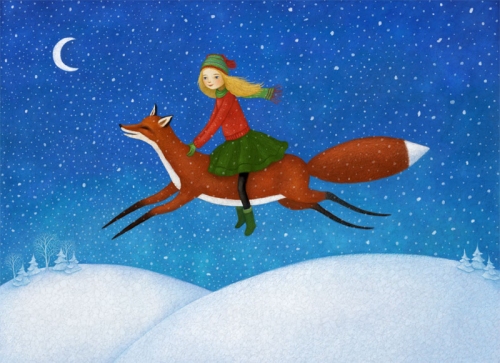
This wonderful holiday inspired illustration was sent in by Joan Charles. She is an illustrator, writer, graphic designer. Her work can be found in gallery exhibitions, magazines, and books. She illustrated the award-winning middle grade adventures Lost in Lexicon and The Ice Castle, written by Pendred Noyce. http://www.joancharles.com
In the last few months I have been asked how someone gets on Writing and Illustrating to show off their work, get an interview, and market a book. Here are the things I consider:
1. Do I know you? Have I met you?
2. Do you follow my blog?
3. Do you leave comments?
4. Do you promote Writing and Illustrating on your website, facebook, or blog?
5. Have you tweeted, reblogged, facebooked or shared information posted on Writing and illustrating?
6. Have you ever been featured on Writing and Illustrating?
7. Have you ever written or shared any information on Writing and Illustrating that would help other writers or illustrators?
8. If you haven’t done any of the above, do you have something to share that the readers who be interested in hearing about?
9. Have you published a book? Is there anything interested in how it got published or something you did that would interest readers?
10. Are you willing to do a book give-a-way?
I can’t know everyone by meeting them in person, but I can get to know you by leaving a comments or following my blog. I have many friends that I hope to meet someday. If you are writing or illustrating a book, you should be looking for people like me who have a large amount of followers and start working to make a connection.
I’m happy for everyone who gets something published, wins a contest, gets an agent, or wins an award and will be happy to include you in a Kudos post. But if you fit into the first seven on the list, you are considered family and will always get your successes promoted on Writing and Illustrating.
Tips: You shouldn’t wait until your book is about to come out to start building connections. Start doing that right now. Think about what type of things you could share that would help other writers. Maybe you don’t feel like you have anything to share, but I bet you do if you think about it. Have you attended a workshop or conference? Have you read a book on how to write or illustrate? You may be revising a story and have an epiphany. Did you learn anything useful during a critique? Maybe you run into an agent or editor who shared knowledge that could be shared? The substance of all these things could be used to write an interesting article. It would be a great way to get your name out there and be noticed.
Just remember when you want to promote yourself, you can’t look like that is all you are interested in doing.
Submissions: Send to Kathy.temean (at) gmail (dot) com. In subject area write, SUBMISSION ARTICLE FOR WRITING AND ILLUSTRATING. Introduce yourself, bio, and send me your article or express you interest in writing an article on…(subject and your idea).
I love when people have a topic they would like to write about that will help other writers and illustrators. If there is not enough meat to the article, I will give you some ideas or suggestions to pump it up. So write something interesting, helpful and start submitting your article to build your list of places and people who will help spread the words when success jumps in your path.
I am sure you have gone to blogs or signed up for newsletters that end up just talking about their book or books. If you haven’t you are lucky. I know I have and it is very disappointing. In fact that tactic could turn someone off and cause them not to buy anything with your name on it. So be careful.
Don’t get buried in only thinking about writing only for your own blog. If you get your article on another blog, you are getting access to a whole new group of people who might end up following your blog. Be smart. Even if you have ten published books, do not turn down someone with a large following saying things like, “I want people to come to my blog, not yours.” This is a statement from someone who doesn’t understand the importance of marketing and someone not savvy enough to see how getting exposure to thousands of new people could be a huge win.
Remember: I am not the only blog with a large following. There are many that could provide opportunities for you.
I am looking to do a Kudos post next week. Any good things happening out there? Let me know.
Call for Christmas Poems or Hanukkah Poems and or illustrations. Will be posting them later this month. Send to Kathy.temean(at)gmail.com Put December Illustration or December Poem in subject area. Thanks!
Talk tomorrow,
Kathy
Filed under:
authors and illustrators,
inspiration,
Marketing a book,
need to know,
opportunity,
Places to sumit Tagged:
Call for Illustrations,
Call for Poems,
Joan Charles,
Pendred Noyce,
Submitting your article 


By: Kathy Temean,
on 12/4/2014
Blog:
Writing and Illustrating
(
Login to Add to MyJacketFlap)
JacketFlap tags:
Call for Poems,
Joan Charles,
Submitting your article,
inspiration,
authors and illustrators,
opportunity,
need to know,
Marketing a book,
Places to sumit,
Pendred Noyce,
Call for Illustrations,
Add a tag

This wonderful holiday inspired illustration was sent in by Joan Charles. She is an illustrator, writer, graphic designer. Her work can be found in gallery exhibitions, magazines, and books. She illustrated the award-winning middle grade adventures Lost in Lexicon and The Ice Castle, written by Pendred Noyce. http://www.joancharles.com
In the last few months I have been asked how someone gets on Writing and Illustrating to show off their work, get an interview, and market a book. Here are the things I consider:
1. Do I know you? Have I met you?
2. Do you follow my blog?
3. Do you leave comments?
4. Do you promote Writing and Illustrating on your website, facebook, or blog?
5. Have you tweeted, reblogged, facebooked or shared information posted on Writing and illustrating?
6. Have you ever been featured on Writing and Illustrating?
7. Have you ever written or shared any information on Writing and Illustrating that would help other writers or illustrators?
8. If you haven’t done any of the above, do you have something to share that the readers who be interested in hearing about?
9. Have you published a book? Is there anything interested in how it got published or something you did that would interest readers?
10. Are you willing to do a book give-a-way?
I can’t know everyone by meeting them in person, but I can get to know you by leaving a comments or following my blog. I have many friends that I hope to meet someday. If you are writing or illustrating a book, you should be looking for people like me who have a large amount of followers and start working to make a connection.
I’m happy for everyone who gets something published, wins a contest, gets an agent, or wins an award and will be happy to include you in a Kudos post. But if you fit into the first seven on the list, you are considered family and will always get your successes promoted on Writing and Illustrating.
Tips: You shouldn’t wait until your book is about to come out to start building connections. Start doing that right now. Think about what type of things you could share that would help other writers. Maybe you don’t feel like you have anything to share, but I bet you do if you think about it. Have you attended a workshop or conference? Have you read a book on how to write or illustrate? You may be revising a story and have an epiphany. Did you learn anything useful during a critique? Maybe you run into an agent or editor who shared knowledge that could be shared? The substance of all these things could be used to write an interesting article. It would be a great way to get your name out there and be noticed.
Just remember when you want to promote yourself, you can’t look like that is all you are interested in doing.
Submissions: Send to Kathy.temean (at) gmail (dot) com. In subject area write, SUBMISSION ARTICLE FOR WRITING AND ILLUSTRATING. Introduce yourself, bio, and send me your article or express you interest in writing an article on…(subject and your idea).
I love when people have a topic they would like to write about that will help other writers and illustrators. If there is not enough meat to the article, I will give you some ideas or suggestions to pump it up. So write something interesting, helpful and start submitting your article to build your list of places and people who will help spread the words when success jumps in your path.
I am sure you have gone to blogs or signed up for newsletters that end up just talking about their book or books. If you haven’t you are lucky. I know I have and it is very disappointing. In fact that tactic could turn someone off and cause them not to buy anything with your name on it. So be careful.
Don’t get buried in only thinking about writing only for your own blog. If you get your article on another blog, you are getting access to a whole new group of people who might end up following your blog. Be smart. Even if you have ten published books, do not turn down someone with a large following saying things like, “I want people to come to my blog, not yours.” This is a statement from someone who doesn’t understand the importance of marketing and someone not savvy enough to see how getting exposure to thousands of new people could be a huge win.
Remember: I am not the only blog with a large following. There are many that could provide opportunities for you.
I am looking to do a Kudos post next week. Any good things happening out there? Let me know.
Call for Christmas Poems or Hanukkah Poems and or illustrations. Will be posting them later this month. Send to Kathy.temean(at)gmail.com Put December Illustration or December Poem in subject area. Thanks!
Talk tomorrow,
Kathy
Filed under:
authors and illustrators,
inspiration,
Marketing a book,
need to know,
opportunity,
Places to sumit Tagged:
Call for Illustrations,
Call for Poems,
Joan Charles,
Pendred Noyce,
Submitting your article 

Have you ever thought about how you decide to buy a book? In my case, unless it is written by a friend or someone has told me I must read a book, I first look at the cover. If the cover has a good title and the cover art grabs me, then I look inside. If the flap jacket pitch sounds interesting, then I flip through the pages.
I look to see if the book has good margins, short paragraphs, and good amount of white space. Long blocky paragraphs exposition, narrative, and description make me think… SKIP!
Studies show that using white space is important because it helps make a book look friendly. And, it is dialogue that provides the eye candy for a reader. As a potential buyer flips through your book, rapid back-and-forth dialogue will make your book more appealing before the reader even reads a word.
So paying attention to dialogue when you revise it is worth the time and effort. I would start by flipping through the manuscript for places that look dense and circle them. Later go back to read and analyze. Ask yourself, “Can I use dialogue to breakup this long paragraph? Would dialogue work better here than what I have now?”
Here are ten things that dialogue can do to help keep your reader reading.
- Dialogue draws a reader into your story.
- Dialogue adds immediacy, picks up the pace, and makes your text easier and more fun to read.
- Dialogue can give the writer a more effective way to provide information about emotional states and inner thoughts.
- Dialogue can reveal motive, insight into a character without overt telling.
- Dialogue can help set the mood of the scene. Example: “This doesn’t feel right… It’s too quiet.”
- Dialogue can intensify the conflict. A confrontation conversation between adversaries can ramp up the tension and remind readers what’s at stake.
- Good Dialogue moves the story forward.
- Dialogue is a useful tool to provide information the reader must know without slowing down the pacing.
- Dialogue is good to use to get out critical bits of information, back-story, and background.
- Dialogue can even be use to suggest a theme.
Of course, dialogue is only one thing to work on while you revise, but the above list can help you can see the many things it can help improve in your novel.
Talk tomorrow,
Kathy
Filed under:
Advice,
article,
inspiration,
Marketing a book,
revisions,
Writing Tips Tagged:
Book Appeal,
Getting readers to buy your book 


By: Kathy Temean,
on 8/6/2014
Blog:
Writing and Illustrating
(
Login to Add to MyJacketFlap)
JacketFlap tags:
Tips,
reference,
Advice,
Amazon Reviews,
How to,
need to know,
Marketing a book,
Advanced Reader Copy,
Amazon Ebook Price Reduction,
Add a tag

- Give out a ARC to people who have a large following on their blogs, but ask them to commit to reading your book and doing a review. Need to work on this months before your book is released. Remember the more reviews you get the better your book will do, but they need to be good reviews.
- For the people who you gave an ARC to, ask them to pass on the book to another person to read to expand your audience.
- Ask everyone who does a review on Amazon to also put it up on Goodreads, too.
- If you have an ebook, consider having Amazon offer it on their Deal of the Day. Reducing the price for a few days or a week, will boost your sales and start word of mouth.
- Have family/friends/colleagues/fans buy your book during a ‘soft’ launch (pre-advertising, or promoting your book on social media).
- Price your book at 99 cents (the lowest allowed by Amazon) and drive as much traffic as you can during your ‘soft’ launch window. Once you have the bar filled you can re-price your book.
Talk tomorrow,
Kathy
Filed under:
Advice,
How to,
Marketing a book,
need to know,
reference,
Tips Tagged:
Advanced Reader Copy,
Amazon Ebook Price Reduction,
Amazon Reviews 


By: Kathy Temean,
on 8/5/2014
Blog:
Writing and Illustrating
(
Login to Add to MyJacketFlap)
JacketFlap tags:
Tips,
list,
Book,
Advice,
authors and illustrators,
Publishing Industry,
Pandemic,
Marketing a book,
Yvonne Ventresca,
Amazon Sales Page,
Maximize Book Sales,
Add a tag

If your book is up on Amazon, you can have an Author Page. This is another opportunity for you, so use it. Here are a few tips:
1. Think of your book’s Amazon.com page as a ¼ page ad in a glossy magazine. You want to build excitement, hype, and the urge to buy rather than dutifully explaining your product.
2. Watch out for typos and grammar, so you put your best foot forward. Make sure what is written makes sense. If you can’t write a good Author Page, most people will think you can’t write a good novel, either.
3. Include review quotes. You want to draw someone into buying your book.
4. Put up book trailers, interviews, and videos on your Amazon page.
5. You can show recent blog posts and twitter entries.
6. List places your events and the dates.
7. Another thing you can do is to encourage a discussion with your fans on this page.
Let’s take a look at Yvonne Ventresca’s Author Page:
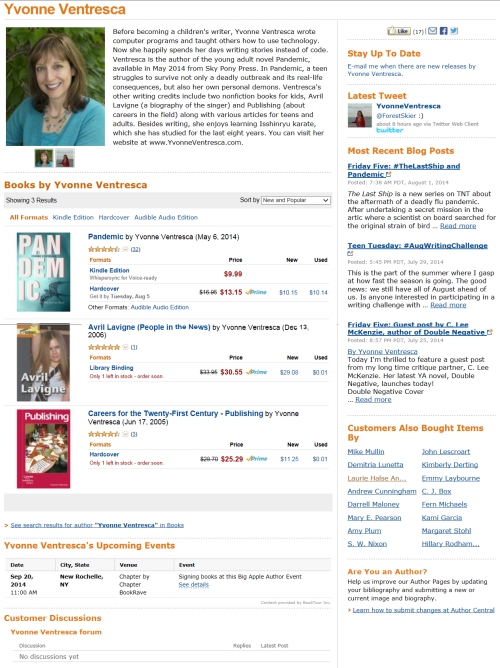
Yvonne has included a lot of the tips on the above list, but I’d like to see her add a few quotes from reviews of Pandemic, a book trailer, and to work on getting a video interview she can put up on the page. Adding these things will maximize the free space Amazon has given her and help increase the sales of her new book.
Good job, Yvonne!
Talk tomorrow,
Kathy
Filed under:
Advice,
authors and illustrators,
Book,
list,
Marketing a book,
Publishing Industry,
Tips Tagged:
Amazon Sales Page,
Maximize Book Sales,
Pandemic,
Yvonne Ventresca 


By: Kathy Temean,
on 8/4/2014
Blog:
Writing and Illustrating
(
Login to Add to MyJacketFlap)
JacketFlap tags:
Tips,
Internet,
Advice,
Process,
article,
authors and illustrators,
Publishing Industry,
Marketing a book,
How to Sell More Books,
Amazon Look Inside,
Amazon Strategies,
How to Sell More Books Workshop,
Add a tag


Let’s take a look at another feature that Amazon offers anyone who sells their books on their site.
Don’t miss out on using this feature. This is another reason why it is important to make sure your first chapter sings.
Personally for me to buy, I look over five things:
Price: I buy lots of ebooks that are offered at $1.99 or less, without having read anything about them.
Cover: I don’t buy books where I don’t like the cover, unless someone else said they were good. I guess I believe in first impressions.
Reviews: I read what book is about and a couple reviews. A few bad reviews don’t stop me from buying, since I’ve read many top-seller books that I thought were great that received a few terrible reviews.
Publisher: I check out who published the book. If it is from a well-known publisher, that could seal the deal right there.
Look inside: If I have not clicked the button to buy, I will “Look inside”. That’s when I put on my editor/agent hat and only give five minutes to the author to grab me before I make my decision. Sometimes the problem is that the book really grabs you and then you have to read the whole thing, even when the desk is piled with work and the kitchen needs to be clean. Many of those books have been self-published, so don’t stick your nose up at them or else you might missed something really good.
Here are some tips on using the “Look inside” feature.
1. Keep front matter to a minimum. You want to make sure the reader can get to the meat of the story quickly. This is also important to do this with the full ebook.
2. Amazon Reviews. Work hard to get as many as you can when you launch the book. This will help raise your ranking and buyers who have read the first pages will look at this, especially if you are self-published.
3. At the end of your book you should ask the reader to write a review. Stats show that this helps you increase your sales numbers.
4. Hot New Releases List on Amazon should be in the forefront of your mind when planning a launch. Talk to your publisher to see if they have planned your novels launch based on other similar books coming out. If there are too many it will hurt your chances of making the list. The list is only good for the first 30 days of a books release.
5. Making sure your blog followers know about your book and doing book tours can help get the word out. It’s nice to get the buzz going, but you need to make sure you keep the big guns for the launch date.
Talk tomorrow,
Kathy
Filed under:
Advice,
article,
authors and illustrators,
Internet,
Marketing a book,
Process,
Publishing Industry,
Tips Tagged:
Amazon Look Inside,
Amazon Strategies,
How to Sell More Books,
How to Sell More Books Workshop 


By: Kathy Temean,
on 8/3/2014
Blog:
Writing and Illustrating
(
Login to Add to MyJacketFlap)
JacketFlap tags:
Tips,
success,
Advice,
article,
How to,
Amazon Rankings,
need to know,
Marketing a book,
demystify,
How to Sell More Books,
Amazon Book Sales Strategies,
NJSCBWI 2014 Workshop,
Add a tag
This week we will look at a few strategies you can use to increase the sales of your books.

If you buy any books on Amazon, you may have noticed they list the Best Selling Books. You should give these categories some thought. It may help you get on one of their lists and getting on one of the lists will greatly improve your chances to get noticed and bought.
1. Try to choose a niche category on Amazon. There are less books, so you will have a better chance to be listed at the top.
2. By clicking the book ranked #100 in any given category, you can consult the Rank to Sales Estimator to see how many sales you need to qualify for that categories Best Seller List.
3. Self Published authors get to choose two categories.
Traditional publishers get to choose up to five categories. Make sure your publisher knows how the system works and how they can use it to their advantage. Choosing “Fiction” might not be the best category due to so many books. (over a million)
4. Example: Kindle Store> Kindle ebooks > Fiction> Mystery, Thriller & Suspense> Thrillers> Political. Your books will still show in all the categories above the one you chose.
A few scenarios:
Fault in Our Stars [Kindle Edition]
Amazon Best Sellers Rank: #6 Paid in Kindle Store (See Top 100 Paid in Kindle Store) This a list of all books (no categories)
#1 in Kindle Store > Kindle eBooks > Teen & Young Adult > Romance > Contemporary
#1 in Books > Teens > Love & Romance
Isla and the Happily Ever After [Kindle Edition]
Amazon Best Sellers Rank: #11,151 Paid in Kindle Store
#100 in Kindle Store > Kindle eBooks > Teen & Young Adult > Romance > Contemporary
The First Third [Kindle Edition]
Amazon Best Sellers Rank: #172,765 Paid in Kindle Store (See how this book was able to make the Top 100 List by picking Social Issues? That’s because there is less competition. This helps give the book a chance to be seen.)
#100 in Kindle Store > Kindle eBooks > Teen & Young Adult > Social Issues
The Year We Disappeared: A Father – Daughter Memoir [Kindle Edition]
Amazon Best Sellers Rank: #9,006 Paid in Kindle Store (See Top 100 Paid in Kindle Store)
#1 in Kindle Store > Kindle eBooks > Teen & Young Adult > Social Issues
#5 in Kindle Store > Kindle eBooks > Teen & Young Adult > Biography
#33 in Kindle Store > Kindle eBooks > Nonfiction > Children’s Nonfiction
Neverwhere [Kindle Edition]
Amazon Best Sellers Rank: #2,867 Paid in Kindle Store (See Top 100 Paid in Kindle Store)
#10 in Kindle Store > Kindle eBooks > Science Fiction & Fantasy > Fantasy > Classics
#11 in Kindle Store > Kindle eBooks > Literature & Fiction > Contemporary Fiction > Fantasy
#79 in Books > Literature & Fiction > Genre Fiction > Horror
5. Make sure you check to make sure the category you pick is on both the book side and the kindle side if you have a print book. Some of the categories do not match up.
6. If you are self-published you will need to do this for yourself, but don’t assume your publisher is choosing the best categories. Do your homework and discuss what you have found with them. But make sure you do this before they list it on Amazon.
Talk tomorrow,
Kathy
Filed under:
Advice,
article,
demystify,
How to,
Marketing a book,
need to know,
success,
Tips Tagged:
Amazon Book Sales Strategies,
Amazon Rankings,
How to Sell More Books,
NJSCBWI 2014 Workshop 


By: Kathy Temean,
on 5/27/2014
Blog:
Writing and Illustrating
(
Login to Add to MyJacketFlap)
JacketFlap tags:
Marketing a book,
Wheels of Change,
Darlene Beck-Jacobson,
Curriculum Guide Example,
Secon Industrial Revolution,
Women gaining independence,
reference,
inspiration,
Process,
Add a tag
WHEELS OF CHANGE CURRICULUM GUIDE
Introduce students to the Industrial Revolution at the turn of the Twentieth Century, using the book as a basis for discussions. This topic is part of the national learning standards and curriculum for U.S. History.
Topics for discussion:
- Introduce causes of the Industrial Revolution and how it changed the workplace and production of goods in America.
- Discuss handmade vs. factory made goods.
- Discuss good change vs. bad change and how it affects individuals and society.
- Discuss women’s emerging independence, their role in the workplace and at home, and how this affects the family.
Objectives:
- To understand the causes and effects of the Second Industrial Revolution (1890’s through WWI)
- To understand how progress has negative as well as positive consequences for individuals and society.
- To understand how even when some members of society benefit from changes, others may not.
- To witness a personal perspective to a period in our nation’s history.
Key Words/Concepts:
- Mass Production
- Assembly lines
- Women’s Suffrage
- Segregation/Prejudice
- Mechanization
Background:
The Industrial Revolution began in the late 1700’s through the 1840’s when goods formerly produced by hand began to be made with machines. Almost every aspect of daily life was influenced in some way. The second wave of industrialization occurred at the turn of the Twentieth Century and lasted until World War I. This revolution revolved around steel, railroad expansion, electricity, chemicals, and communication.
Mass production of steel replaced hand wrought iron. Blacksmiths – like Henry Johnson in WHEELS OF CHANGE – would no longer be needed to produce the rails, machine components and tools used to manufacture goods and move them from one place to another. Railroads replaced steamboats to transport goods over longer lasting steel rails. Electricity allowed factories to increase production of clothing and household goods. It also made it possible for Henry Ford to redesign the factory using tools and specialized machines positioned in a unique sequence to eliminate unnecessary human movement. The assembly line was born. More goods made in less time at a cheaper cost.
It took Mr. Soper weeks to make one of his carriages. It also took Henry days to hammer out all the iron needed to support the carriage body. The new factory system eliminated this labor-intensive process.
Part One: Making the topic relevant:
Begin a discussion on all the modern conveniences we all enjoy thanks to factory made products. When things get lost or broken we can easily and cheaply replace them.
Part Two: Read WHEELS OF CHANGE with students and start a discussion using the following topics:
- Why was Emily worried about automobiles coming to town? Was her worry real or imagined?
- How did having electricity and a telephone change life for Emily and her family?
- Emily’s mama had few modern appliances or household gadgets. How would having these things change her life?
- Why were some people upset when papa employed an African American blacksmith? How did prejudice impact some of the decisions actions taken in the story?
- Women could not vote and had few rights in 1908. Why do you think so many people were opposed to allowing women the right to vote?
- Why was the telegraph and mail service so important in the early 1900’s?
Concluding Activity: Have students write about what their lives would be like without electricity, telephones, or motor cars. Would some aspects of life be better without those things?
Or, have them write about prejudice and being judged by the color of your skin. Should groups be singled out based on ethnic origin, religion, or political beliefs? Where in the world are these things still taking place today?
Stop back on Sunday to view Darlene’s Study Guide.
Talk tomorrow,
Kathy
Further Study:
http://en.wikipedia.org/wiki/Second_Industrial_Revolution
www.ushistoryscene.com/uncategorized/secondindustrialrevolution/
Filed under:
inspiration,
Marketing a book,
Process,
reference Tagged:
Curriculum Guide Example,
Darlene Beck-Jacobson,
Secon Industrial Revolution,
Wheels of Change,
Women gaining independence 


By: Kathy Temean,
on 5/27/2014
Blog:
Writing and Illustrating
(
Login to Add to MyJacketFlap)
JacketFlap tags:
Wheels of Change,
Darlene Beck-Jacobson,
Curriculum Guide Example,
Secon Industrial Revolution,
Women gaining independence,
reference,
inspiration,
Process,
Marketing a book,
Add a tag
WHEELS OF CHANGE CURRICULUM GUIDE
Introduce students to the Industrial Revolution at the turn of the Twentieth Century, using the book as a basis for discussions. This topic is part of the national learning standards and curriculum for U.S. History.
Topics for discussion:
- Introduce causes of the Industrial Revolution and how it changed the workplace and production of goods in America.
- Discuss handmade vs. factory made goods.
- Discuss good change vs. bad change and how it affects individuals and society.
- Discuss women’s emerging independence, their role in the workplace and at home, and how this affects the family.
Objectives:
- To understand the causes and effects of the Second Industrial Revolution (1890’s through WWI)
- To understand how progress has negative as well as positive consequences for individuals and society.
- To understand how even when some members of society benefit from changes, others may not.
- To witness a personal perspective to a period in our nation’s history.
Key Words/Concepts:
- Mass Production
- Assembly lines
- Women’s Suffrage
- Segregation/Prejudice
- Mechanization
Background:
The Industrial Revolution began in the late 1700’s through the 1840’s when goods formerly produced by hand began to be made with machines. Almost every aspect of daily life was influenced in some way. The second wave of industrialization occurred at the turn of the Twentieth Century and lasted until World War I. This revolution revolved around steel, railroad expansion, electricity, chemicals, and communication.
Mass production of steel replaced hand wrought iron. Blacksmiths – like Henry Johnson in WHEELS OF CHANGE – would no longer be needed to produce the rails, machine components and tools used to manufacture goods and move them from one place to another. Railroads replaced steamboats to transport goods over longer lasting steel rails. Electricity allowed factories to increase production of clothing and household goods. It also made it possible for Henry Ford to redesign the factory using tools and specialized machines positioned in a unique sequence to eliminate unnecessary human movement. The assembly line was born. More goods made in less time at a cheaper cost.
It took Mr. Soper weeks to make one of his carriages. It also took Henry days to hammer out all the iron needed to support the carriage body. The new factory system eliminated this labor-intensive process.
Part One: Making the topic relevant:
Begin a discussion on all the modern conveniences we all enjoy thanks to factory made products. When things get lost or broken we can easily and cheaply replace them.
Part Two: Read WHEELS OF CHANGE with students and start a discussion using the following topics:
- Why was Emily worried about automobiles coming to town? Was her worry real or imagined?
- How did having electricity and a telephone change life for Emily and her family?
- Emily’s mama had few modern appliances or household gadgets. How would having these things change her life?
- Why were some people upset when papa employed an African American blacksmith? How did prejudice impact some of the decisions actions taken in the story?
- Women could not vote and had few rights in 1908. Why do you think so many people were opposed to allowing women the right to vote?
- Why was the telegraph and mail service so important in the early 1900’s?
Concluding Activity: Have students write about what their lives would be like without electricity, telephones, or motor cars. Would some aspects of life be better without those things?
Or, have them write about prejudice and being judged by the color of your skin. Should groups be singled out based on ethnic origin, religion, or political beliefs? Where in the world are these things still taking place today?
Stop back on Sunday to view Darlene’s Study Guide.
Talk tomorrow,
Kathy
Further Study:
http://en.wikipedia.org/wiki/Second_Industrial_Revolution
www.ushistoryscene.com/uncategorized/secondindustrialrevolution/
Filed under:
inspiration,
Marketing a book,
Process,
reference Tagged:
Curriculum Guide Example,
Darlene Beck-Jacobson,
Secon Industrial Revolution,
Wheels of Change,
Women gaining independence 


By: Kathy Temean,
on 9/30/2013
Blog:
Writing and Illustrating
(
Login to Add to MyJacketFlap)
JacketFlap tags:
Advice,
Process,
Middle Grade Novels,
authors and illustrators,
Marketing a book,
Newbery Winner,
HarperCollins Childrens,
The One and Only Ivan,
Increase your sales,
School Discussion Guide,
Add a tag
This is an excellent discussion guide for Kate Applegate’s Newbery winning book, THE ONE AND ONLY IVAN. With this one piece Kate is showing not only helping teachers know how to use her book with their classes, but she is also, generating interest in her book, encouraging teachers to share it with her readers, and get invited to their school. Bottom Line: Increasing sales.
Are you putting out something this high end? Next, I will share a picture book Discussion Guide. I hope these will get you thinking about what you can do for your book.
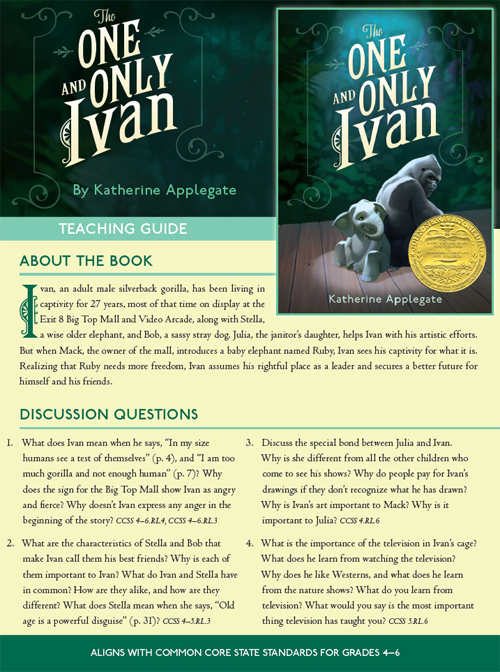
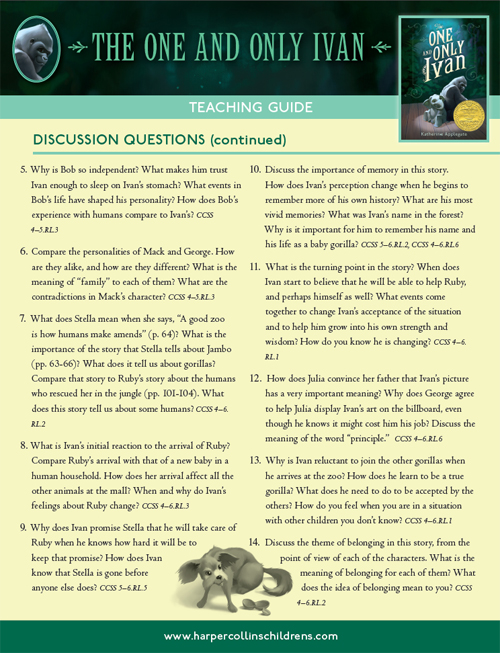
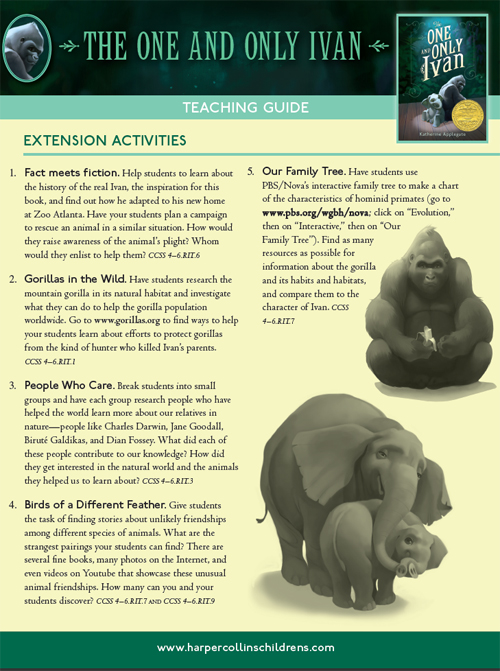
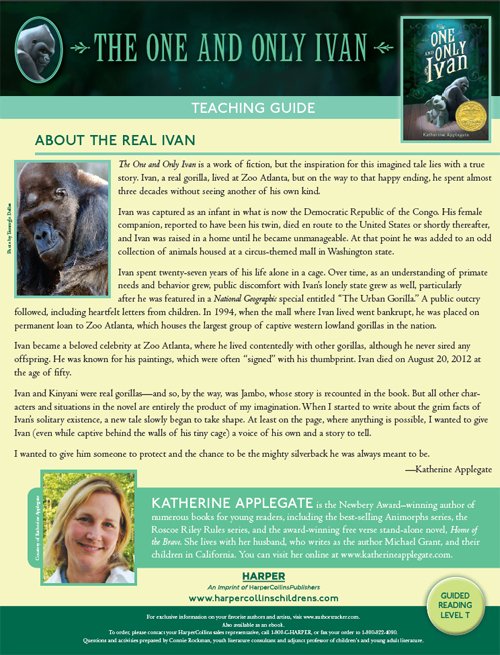
If your publisher is not planning on creating something like this for you, don’t let that stop you from doing all the things you can to look professional and grab more sales.
Talk tomorrow,
Kathy
Filed under:
Advice,
authors and illustrators,
Marketing a book,
Middle Grade Novels,
Process Tagged:
HarperCollins Childrens,
Increase your sales,
Newbery Winner,
School Discussion Guide,
The One and Only Ivan 


By: Kathy Temean,
on 9/29/2013
Blog:
Writing and Illustrating
(
Login to Add to MyJacketFlap)
JacketFlap tags:
HarperCollins,
Author,
Book,
inspiration,
Young Adult Novel,
How to,
Lauren Oliver,
Marketing a book,
Book Discussion Guide,
Getting school visits,
Panemonium,
Add a tag
I am posting this because I think all of us should be thinking past having a website, blog, and a facebook page and start thinking about selling our books. This is an excellent discussion guide for Lauren Oliver’s fabulous book, PANDEMONIUM. With this one piece she is showing that she is a true professional, generating interest in reading her book, and providing content for teachers to encourage them to invite her in to their school. Are you putting out something this high end? Next week I will share an excellent middle grade discussion guide and a picture book discussion guide. I hope these will get you thinking about doing more than just putting up a website and hoping someone calls.

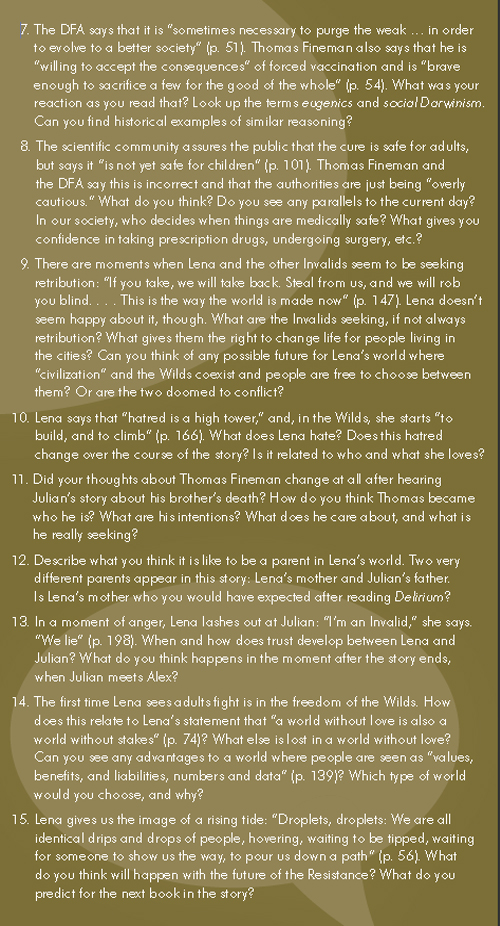
Talk tomorrow,
Kathy
Filed under:
Author,
Book,
How to,
inspiration,
Marketing a book,
Young Adult Novel Tagged:
Book Discussion Guide,
Getting school visits,
HarperCollins,
Lauren Oliver,
Panemonium 


By: Kathy Temean,
on 7/2/2013
Blog:
Writing and Illustrating
(
Login to Add to MyJacketFlap)
JacketFlap tags:
Dana Lynn Smith,
Marketing a book,
demystify,
Maggie Lyons,
Finding and settiing up book reviews,
The Savvy Book Marketer,
book reviews,
Uncategorized,
Advice,
article,
Add a tag
Last week we talked about the importance of getting book reviews, so I thought you might be interested in reading Dana Lynn Smith’s article that I found on Maggie Lyons Blog http://www.maggie-lyons.blogspot.com/. Maggie is always on the lookout for writing information to share. I think Dana’s information will really help you promote your books.
 Six Common Myths about Book Reviews
Six Common Myths about Book Reviews
by Dana Lynn Smith, the Savvy Book Marketer
Book reviews are a powerful promotional tool, but many authors have some misconceptions about reviews and how to obtain them. Here are some common myths about getting book reviews.
Myth #1 – Book reviews are just for new books.
It’s true that book review journals read by librarians and booksellers review books at or soon after publication. It’s best to focus your review efforts during the first year of a book’s life, but some venues will review older books.
Myth #2 – No one will review a self-published book.
It is more challenging for self-published authors and small presses to get reviews in certain venues, but it’s certainly not impossible. Self-published books are far more likely to be reviewed if they are produced to industry standards (well written, edited and designed). A number of book review websites welcome self-published books or even focus specifically on them, and there are several book journals like Midwest Book Review that are friendly to independent and small presses.
Myth #3 – Book reviews are just for books being sold to bookstores and libraries.
Trade journals like Publishers Weekly and Library Journal are designed to meet the needs of booksellers and librarians, so they focus on books that are available through major distributors and wholesalers at standard discounts. But there are plenty of other places to get book reviews, including book blogs, topical blogs, online bookstores, specialty publications, literary magazines, and reader networks.
Myth #4 – You can’t get reviews for ebooks.
It takes some extra research to identify revenue venues that will review books that are available only in ebook format. Many reviewers accept only printed books, although that is slowly changing as the use of ebook readers becomes more widespread. There are several websites, such as Kindle Obsessed, that focus on ebooks.
Myth #5 – No one pays attention to the reviews in online bookstores.
It’s true that some shoppers view online reviews with skepticism, but I do believe that reviews (or the lack of them) influences shoppers in online bookstores. In my book, How to Get Your Book Reviewed, I cite a research study by the Yale School of Management that backs this up. With so many books to choose from, shoppers are often looking for some factor to help them decide between several books.
Having very few or no reviews on an Amazon sales page can give the impression that the book isn’t very popular. Reviews can also give the shopper more insight into the book, beyond the product description.
Be sure to encourage customers and book reviewers to post their review or recommendation on Amazon.
Myth #6 – It’s not worth the effort of pursing reviews.
Book reviews serve two basic purposes: they bring your book to the attention of people who might not have learned about it otherwise, and they help potential customers decide if your book is a good fit for them. The more reviews you have, and the more places those reviews appear, the greater your reach and your selling power.
All book marketing plans should include a strategy for maximizing the value of reviews, endorsements and testimonials.
About the Author
Dana Lynn Smith, The Savvy Book Marketer, helps authors and indie publishers learn how to sell more books through her how-to guides, blog, newsletter, and private coaching.
Learn how to use reviews to sell more books in her comprehensive guide, How to Get Your Book Reviewed, and get more book marketing tips at TheSavvyBookMarketer.com.
Talk tomorrow,
Kathy
Filed under:
Advice,
article,
demystify,
Marketing a book,
Uncategorized Tagged:
book reviews,
Dana Lynn Smith,
Finding and settiing up book reviews,
Maggie Lyons,
The Savvy Book Marketer 


By: Kathy Temean,
on 4/8/2013
Blog:
Writing and Illustrating
(
Login to Add to MyJacketFlap)
JacketFlap tags:
Spike the Mixed up Monster,
Interview,
Tips,
Process,
authors and illustrators,
Melissa Sweet,
Simon & Schuster,
Marketing a book,
Susan Hood,
Curriculum Guide,
Paula Wiseman Books,
Add a tag
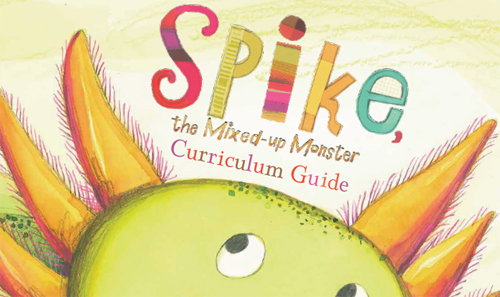
Why create a Curriculum Guide for your books?
“A discussion guide and/or activity guide is a valuable way for teachers, librarians and parents to give a book more depth and breadth,” says illustrator Melissa Sweet who collaborated with me on SPIKE, THE MIXED-UP MONSTER. Today, there’s more interest than ever in these guides. Why? Two words: Common Core. Educators everywhere are looking for ways to incorporate this new mandate.
And once you have a guide, it’s a win-win-win situation!
- For kids, the games, crafts and activities are fun. They encourage kids to play with ideas they’ve learned from the book and to dive deeper into the subject matter.
- For teachers, the guide helps them incorporate your book into lesson plans, especially if the guide aligns with the Common Core.
- For you, the guide increases your book’s exposure and lets you elaborate on ideas you’ve introduced. It makes a dandy handout for school and library visits and can drive traffic to your website.

What are the different kinds of guides?
Activity Guides
These offer interactive activities, such as cut-out masks, holiday cards, finger puppets, bookmarks and so on. They may include directions for games, activities, songs, recipes, and crafts.
Discussion Guides
These guides have more text, fewer cut-outs. They might provide interviews with the author and illustrator, discussion prompts, projects and extension activities. They list questions to ask kids and suggest additional books, websites and resources. See Michelle Markel and Melissa Sweet’s Discussion Guide for BRAVE GIRL.
All of the Above
Our SPIKE, THE MIXED-UP MONSTER Curriculum Guide has something for everyone—pages of interactive cut-out, crayon and drawing activities for kids, plus book-related questions that align with the Common Core for educators.
How do you create a Curriculum Guide?
Talk to your publisher. More and more houses are interested in developing them. Some will work with the author and illustrator. Others will hire an outside reading specialist to write discussion questions, illustrated with pick-up art from the book.
For our book SPIKE, THE MIXED-UP MONSTER, Melissa Sweet and I agreed to work on the guide together. I came up with the games and wrote the copy. (As the former Children’s Content Director of Nick Jr. Magazine, they were right up my alley!) Melissa did sketches for some pages and we used pick-up art from the book for other pages. We submitted the “manuscript” and later sketches to our editor and then worked with the Simon & Schuster marketing department to have the guide designed and copy-edited. Simon & Schuster also hired a literacy specialist, Tracie Vaughn Zimmer to add a discussion guide with questions that align to the Common Core. Tracie says, “I’ve been writing guides for 10 years. My focus is to really try to find what’s unique about the book and bring that forward for teachers to use in their classroom. The new push is the alignment with The Common Core Standards, which I’ve been trained in extensively over the last two years.”
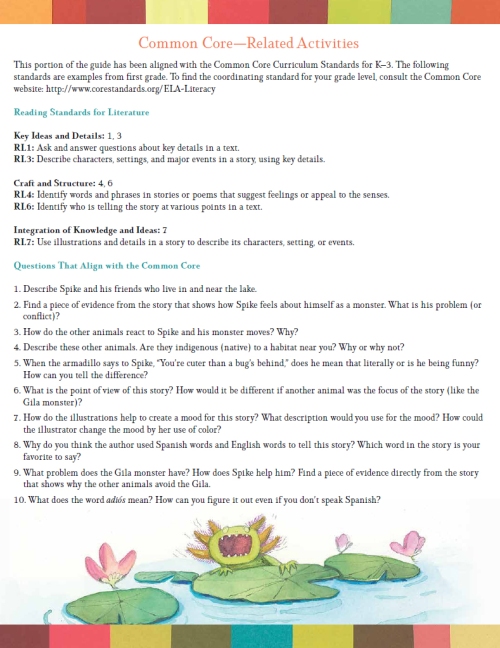
Who pays the costs?
Sometimes the publisher, sometimes you! For my book JUST SAY BOO,
I worked with my illustrator Jed Henry to create Halloween cards, masks, paper dolls, a charades card game, and more. Jed agreed to create some original art and we used some pick-up art as well. We both donated our time and then I hired a former Nick Jr. designer, Jennifer Starr, to put it together. This is key. Without a good designer, your guide won’t look professional or be as appealing.
How long does it take?
It depends on the scope of the guide. Our SPIKE guide is 15-pages long and includes original art so the production process took several months. Guides that are mostly text or use pickup art will take less time.
How does it get distributed?
You, your illustrator and your publisher post the guide as a free downloadable PDF on your websites, Facebook, Twitter and Pinterest accounts. I also take copies along to school and library visits, conferences and other venues. To keep costs down, I might copy one or two pages, do those activities with the kids, and then provide the school the link for more. Or you can email your school contacts ahead of time and have the school download the guide before your visit.
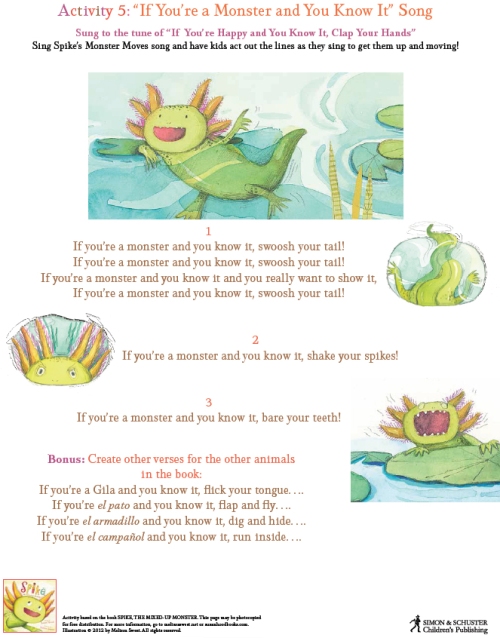
To download the SPIKE, THE MIXED-UP MONSTER Curriculum Guide, visit: www.susanhoodbooks.com
For wonderful ideas for teaching SPIKE developed by the professors of Lesley University, see http://march23rdhandout.blogspot.com/p/panel-i.html
Have more questions? To get more information about creating guides, contact [email protected].
Talk tomorrow,
Kathy
Filed under:
authors and illustrators,
Interview,
Marketing a book,
Process,
Tips Tagged:
Curriculum Guide,
Melissa Sweet,
Paula Wiseman Books,
Simon & Schuster,
Spike the Mixed up Monster,
Susan Hood 


By: Kathy Temean,
on 3/11/2013
Blog:
Writing and Illustrating
(
Login to Add to MyJacketFlap)
JacketFlap tags:
Self-Published Book Awards,
Contest,
awards,
Self-publishing,
Competition,
authors and illustrators,
Publishing Industry,
opportunity,
Writer's Digest,
Marketing a book,
Add a tag
 We have been talking about self-publishing for the last few weeks, so I thought you might be interested in reading about this annual contest. The entry fee is high, but if you have a self-published book you think is good, entering this premier self-published competition could help get your book noticed. It is exclusively for self-published books.
We have been talking about self-publishing for the last few weeks, so I thought you might be interested in reading about this annual contest. The entry fee is high, but if you have a self-published book you think is good, entering this premier self-published competition could help get your book noticed. It is exclusively for self-published books.
Writer’s Digest hosts the 21st annual self-published competition — the Annual Self-Published Book Awards. This self-published competition spotlights today’s self-published works and honors self-published authors.
Early Bird Deadline: April 1, 2013
Wondering what is in it for you?
- A chance to win $3,000 in cash
- Get national exposure for your work
- Catch the attention of prospective editors and publishers
- A paid trip to the ever-popular Writer’s Digest Conference in New York City!
How to enter: register and pay online or download a printable entry form. (Early Bird Entry fees are $100 for the first entry, and $75 for each additional entry.)

Enter your book into one or more of these categories:
- Mainstream/Literary Fiction
- Genre Fiction
- Nonfiction
- Inspirational (Spiritual, New Age)
- Life Stories (Biographies, Autobiographies, Family Histories, Memoirs)
- Children’s/Picture books
- Middle-Grade/Young Adult books
- Reference Books (Directories, Encyclopedias, Guide Books)
- Poetry
One Grand Prize Winner will receive:
- $3,000 cash and a trip to the Writer’s Digest Conference in New York City
- A priceless endorsement for their book from the Writer’s Digest Editors–10 copies of their book for submission to major publishing review houses.
- A one-year membership for Independent Book Publishers Association (IBPA), the largest not-for-profit trade association representing more than 3,000 independent book publishers, courtesy of Brian Jud & Book Marketing Works, LLC.
- Guaranteed acceptance in a special sales catalog and national representation through 1,800 salespeople who sell to non-bookstore markets, courtesy of Brian Jud & Book Marketing Works, LLC.
- A one-year membership to Author-U, courtesy of Brian Jud & Book Marketing Works, LLC.
- A copy of Show Me About Book Publishing and consultation with Book Shepherd Judith Briles (valued at $500), courtesy of Brian Jud & Book Marketing Works, LLC.
- A guaranteed review in Midwest Book Review, courtesy of Brian Jud & Book Marketing Works, LLC.
Nine First-Place Winners will receive:
- $1,000 cash and promotion in Writer’s Digest
- A one-year membership to Small Publishers Association of North America (SPAN), courtesy of Brian Jud & Book Marketing Works, LLC.
- A guaranteed review in Midwest Book Review, courtesy of Brian Jud & Book Marketing Works, LLC.
- A one-year membership to Book Central Station where you can find lists of suppliers rated by previous clients, provided by Brian Jud & Book Marketing Works, LLC.
- An ebook titled Beyond the Bookstore by Brian Jud (with CD).
All Grand Prize and First Place winners will:
- Be featured on the Writer’s Digest website
- Receive a copy of The Complete Guide to Self-Publishing, 4th Edition by Tom and Marilyn Ross.
- $100 worth of Writer’s Digest Books
Honorable Mention Winners will receive $50 worth of Writer’s Digest Books and be promoted on www.writersdigest.com.
All other entrants will receive a brief commentary from the judges along with a link to the entrant’s website (only if the URL is accurate) on writersdigest.com.

THE RULES:
1. The competition is open to all English-language self-published books for which the authors have paid the full cost of publication, or the cost of printing has been paid for by a grant or as part of a prize.
2. You may register and pay online for faster service.
3. Entrants must send a printed and bound book. Entries will be evaluated on content, writing quality and overall quality of production and appearance. No handwritten books are accepted.
4. All books published or revised and reprinted between 2008 and 2013 are eligible. (Writer’s Digest may demand proof of eligibility of semifinalists.)
5. All books not registered online must be accompanied by an Official Entry Form. Photocopies of the Official Entry Form are acceptable. You may enter more than one book and/or more than one category; however, you must include a separate book, entry form and the additional fee for each entry.
6. We accept check, money order or credit card payment for the required judging fee. The early bird entry fees are $100 for the first entry, $75 for each additional entry must accompany submissions. For books submitted after the April 1 early bird deadline, the fees are $110 for the first entry, $85 for each additional entry. Payment must accompany submissions.
7. All early bird entries must be postmarked no later than April 1, 2013. Entries submitted for the regular deadline must be postmarked by May 1, 2013. All winners will be notified by October 14, 2013. If you wish to receive confirmation that your entry was received before the deadline, we recommend using certified mail or some other tracking method to send your entry.
8. Judges reserve the right to withhold prizes in any category. Judges reserve the right to re-categorize entries.
9. Books which have previously won awards from Writers Digest are not eligible.
10. Employees of F+W Media, Inc. and Book Marketing Works, LLC and their immediate families are not eligible. Books published by Abbott Press are not eligible to participate.
11. Writer’s Digest is not responsible for the loss, damage or return of any books submitted to the competition.
Talk tomorrow,
Kathy
Filed under:
authors and illustrators,
awards,
Competition,
Contest,
Marketing a book,
opportunity,
Publishing Industry,
Self-publishing Tagged:
Self-Published Book Awards,
Writer's Digest 


By: Kathy Temean,
on 7/8/2012
Blog:
Writing and Illustrating
(
Login to Add to MyJacketFlap)
JacketFlap tags:
Author,
marketing,
Tips,
Advice,
article,
Conferences and Workshops,
Marketing a book,
Academic School Standards,
Jane Kirkland,
Jennifer Reinharz,
Talk A Walk,
Add a tag
Tying Your Book to Academic Standards and
Using Academic Standards as a Key Marketing Tool
By: Jennifer Reinharz, M.S.Ed
 Jane Kirkland is the creator of Take a Walk Books (www.takeawalk.com), a self published nature book series as well as an accomplished and award winning author, speaker, photographer and TV/radio personality.
Jane Kirkland is the creator of Take a Walk Books (www.takeawalk.com), a self published nature book series as well as an accomplished and award winning author, speaker, photographer and TV/radio personality.
When educators purchase books and materials to use in the classroom, they make sure their selections are aligned with the state’s academic standards. When writers market their work, they think about the best way to appeal to the audience.
By tying her books to academic standards, Ms. Kirkland has found a creative but practical way to bridge these two worlds. She recommends that writers try it as it is an opportunity to market one’s work, sell more books and programs, and gain a deeper understanding of the audience, school-aged children.
What are academic standards?
Academic standards are a list of learning goals that children must meet in every grade or every other grade. They are divided into two types: content standards or what a student needs to know and performance standards or how well a student can perform that goal.
Standards exist in each of the main content areas: English/Language Arts (ELA), Social Studies, Math and Science. The academic standards do not provide materials or assessment. It is the role of the teacher and administrators to determine the method or curriculum for teaching these goals.
Academic standards for students in grades K-12 continue to evolve. Standards typically vary by state and in some cases, by city. In 2010, the National Governors Association Center for Best Practices, Council of Chief State School Officers created a set of standards called the Common Core State Standards for Math and English/Language Arts (which includes literacy in Social Studies and Science). To date, 45 states have voluntarily adopted these standards. Effective September 2012, all of the school districts in these states will align their related curriculum with the new learning goals.
What does this mean for writers?
Administrators and teachers are and will continue to pay close attention to fiction and nonfiction materials purchased for the classroom to ensure that they fit with the academic standards.
By correlating one’s work to current standards, it becomes a viable teaching tool that helps to supplement curriculum. It also might become recommended or required reading. This can help sell more books.
By correlating school programs to the standards, a writer expands her funding sources beyond parent associations to include the school district and educational grants. It can also help to secure annual school visits and sell more programs.
Knowing the standards gives a writer a better understanding of what the reader is supposed to know and be able to do at his grade level.
Here’s an example:
With her Take a Walk Books in mind, Ms. Kirkland read the 4th grade Pennsylvania Science Standards. One 4th grade learning goal is that children must be able to compare lotic with lentic water systems. To help students understand this concept, she included the definitions of lotic and lentic in t

By: Kathy Temean,
on 8/17/2011
Blog:
Writing and Illustrating
(
Login to Add to MyJacketFlap)
JacketFlap tags:
2012 NJSCBWI Conference,
Speaking Application,
Events,
authors and illustrators,
opportunity,
children writing,
earn money,
Compensation,
Conferences and Workshops,
Marketing a book,
Add a tag
This year the New Jersey SCBWI Chapter is asking authors and illustrators who want to present at our annual conference to fill out the form attached in this post to be considered. You do not have to live in the state for be considered.
Please check back for the form link later today. I was not able to upload it to the New Jersey SCBWI website, due to server problems. I know there are a lot of you who have been waiting for this information, so I decided to paste it into the blog. Compensation is listed at the end and link at bottom.
New Jersey SCBWI 2012 Conference
Workshop/Intensive Proposal Application
All potential workshop and intensive presenters must submit a written proposal. We are interested in a variety of types of workshops/intensives, both lecture and hands-on.
Submit a separate form for each workshop/intensive you are proposing.
Conference Dates: June 8-10, 2012 2012 Conference Location: Wyndham Princeton
Proposal Due Date: November 15, 2011
We will strive to notify presenters by January 15, 2012
Submit Form to:
[email protected] - Subject: Conference Proposal Application
Title of Workshop/Intensive: __________________________________
Circle one:
Workshop presentation (45 minutes) or Friday Pre-conference intensive (4 hours)
Name:___________________________________________________
Phone: __________________________________________________
Address: _________________________________________________
Email: ___________________________________________________
Website: _________________________________________________
Will You Partner with Other Presenters for Your Workshop? ___________
If so, list their names, addresses, phone numbers,emails,and websites:
________________________________________________________
________________________________________________________
________________________________________________________
Description (Please attach outline) of workshop in 150 words or less:______
________________________________________________________
________________________________________________________
________________________________________________________
________________________________________________________
________________________________________________________
_______________________________________________________
________________________________________________________
Title of Workshop/Intensive: __________________________________
Maximum number of workshop participants? ______________________
What will your workshop focus on?
Writing Illustrating Marketing Other ______________________________

By: Kathy Temean,
on 8/10/2011
Blog:
Writing and Illustrating
(
Login to Add to MyJacketFlap)
JacketFlap tags:
Author,
Technology,
Advice,
Process,
Book Trailer,
article,
How to,
Making a Book Trailer,
Marketing a book,
Chrstine Norris,
Add a tag
 Christine Norris attended the “How to Make a Book Trailer” Workshop that I conducted at the NJSCBWI Conference in June, so I was happy to see the results of Christine Norris’ Book Trailer and asked her to share her experience with you.
Christine Norris attended the “How to Make a Book Trailer” Workshop that I conducted at the NJSCBWI Conference in June, so I was happy to see the results of Christine Norris’ Book Trailer and asked her to share her experience with you.
I hope it will give you the encourage you need to try your hand in developing your own trailer.

Here’s Christine:
Making a Book Trailer
Christine Norris
After five published novels, I’ve been around the block as far as book promotion is concerned. I’ve done it all – brochures, postcards, bookmarks, fun little
book-themed giveaways, and I just received an order of really cute buttons. And I’m a total cheapskate about it – if I can get it cheap or free, I am all about
it. Part of being a cheapskate promoter is learning to do things for yourself. And so I’ve learned Photoshop (actually I have an Open Source version – free,
of course), and mastered brochure making and business card design so that I can make my own promotional items. And most of them have turned out really well.
Ever since the book trailer craze started, I’ve wanted to have a book trailer. If you haven’t seen one, it’s like a mini-movie for a book, like a moving advertisement. But I had no idea where to begin. Until I took Instructional Media for Graduate School, I had never used Windows Movie Maker, but for that course I was forced to learn. And it was SO FUN, and really SO EASY. Once I had the software skill, I knew that I could make a trailer, but wasn’t sure if I could do it justice. You can’t just slap some slides together and plop down music and go. Then I went to NJSCBWI’s annual conference this year, and took Kathy’s book trailer workshop, and she gave us some great pointers about targeting the audience, scripting, video, and types of trailers. Which was all I needed to get me going in the right direction. Here’s what I learned while making the trailer for my latest book, THE MIRROR OF YU-HUANG:
Concept is Key
This was without a doubt the hardest part for me. I have the skills to put together a movie, including audio and voice and sound effects if I need them, but what should be the focus of the trailer? I had at least two false starts, where I liked the concept, but it was going to be much too long and involved for a trailer. A trailer is short and sweet, about one minute long. How to grab and hold someone’s attention and get across the theme of the book in one minute? I finally decided, since THE MIRROR OF YU-HUANG is the third book in my series, to focus on the theme of the series itself, briefly revisiting the first two books. It helped to build up the suspense AND it had the added bonus of showing the rest of the series for those who hadn’t read them. Finding that concept was the hardest part of making the trailer. Once I had that down, the rest was cake.
Don’t use too many bells and whistles.
Movie Maker has TONS of them – transitions, title animations, video thingys. The temptation is there to use them all. Resist. Pick a theme and stick with it. All of my
text slides have the same background and font. I use mostly one type of transition for the entire thing, except at the most dramatic point of the trailer. It makes the important part – the
This year I will be teaching a workshop on Making a Book Trailer. I wanted to share with you two excellent examples of book trailers that work. They both use the beautiful artwork from their book and the sounds (music and voice) add the icing on the cake. Both trailers make you want to run out and buy the books, which is the mark of an excellent video. I don’t think either Dan or Audrey made their own trailer, but you can learn to create something just as nice to promote yourself and book.
Audrey Vernick will be at this year’s NJSCBWI conference and Dan Yaccarino is scheduled for 2012.
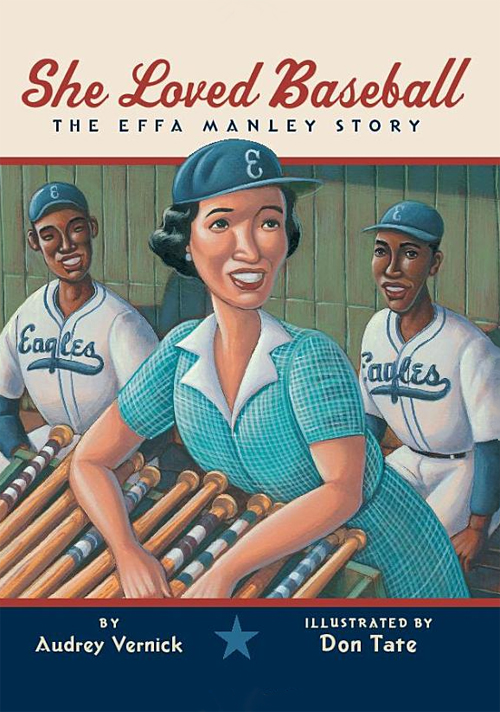

Dan’s book is available on March 8th. You can always buy it now and have him sign it next year at the conference.
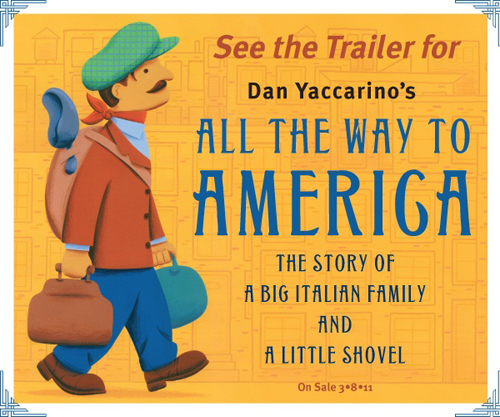

I will spare you the trailers I have seen that don’t come close to selling a book. Better to not use a book trailer, if it will make potential buyers run for the hills.
Talk tomorrow,
Kathy
Filed under:
inspiration,
marketing,
Marketing a book Tagged:
Audrey Vernick,
Book Trailers,
Dan Yaccarino 








By: Kathy Temean,
on 3/31/2010
Blog:
Writing and Illustrating
(
Login to Add to MyJacketFlap)
JacketFlap tags:
marketing,
Tips,
magazine,
Authors,
writing,
Advice,
Oprah,
How to,
Marketing a book,
Add a tag
 The main character in my YA novel gets invited to go on Oprah’s TV show, but she is the daughter of a famous politician and she does not exist. So unless you are a celebrity or infamous for doing something unusual or know someone in Oprah’s inner circle, you probably will not be successful getting on her show.
The main character in my YA novel gets invited to go on Oprah’s TV show, but she is the daughter of a famous politician and she does not exist. So unless you are a celebrity or infamous for doing something unusual or know someone in Oprah’s inner circle, you probably will not be successful getting on her show.
Susan Harrow, who wrote the ebook Get into O Magazine, points out that it is nearly impossible to get on the Oprah TV Show, but it is possible to get into O Magazine and once you make it there it could be a stepping stone to get on her TV show. The show isn’t going off the air until October 2011, so it is worth shooting for the stars.
So what is it that editors are looking for? Susan says there is about a dozen types of stories and interview subjects that the editors look for when they sift through the thousands of pitches, emails, books and other solicitations. Here they are:
- A book that women want to read. (Authors, pay attention.) It must be well-written, moving, funny, dramatic, or it must deal with a topic that Oprah believes women must know about. That’s why you must do your research and watch the show so you understand Oprah’s hot-button topics.
- Unusual gifts for pets, or a heart-warming story about your relationship with your pet. After the magazine featured BowWowTV, a company that makes DVDs for dogs, Denise Loren was able to get her product into 100 retail outlets.
- A story about how you inspired some great shift your community.
- Out-of-the ordinary tips from the experts on how to save money, do good for others, and live to the fullest. After business advisor Stephen Shapiro, author of the book Goal-Free Living: How to Have the Life You Want NOW!, was featured in O Magazine, he got calls from Entrepreneur, Investor’s Business Daily and Family Circle.
- Breakthroughs in health, anti-aging, dealing with health care and optimal healthful living. When the magazine featured the Heart Center for Women at Rush University Medical Center, patients flocked to the center, says Dr. Annabelle Volgman.
- A service that has helped thousands of people and that others can use when the economy is bad.
- A product, service, cause or issue that helps children love in a unique way.
- Suggestions on how women can stop obsessing over what they want and, instead, start appreciating what they have.
- How you’ve gotten through some of the toughest times in your life and advice you can share on how other women can do the same.
Read the rest of Susan’s dozen by clicking on this link. http://www.publicityhound.com/free_publicity/Articles/o_magazine.html
O, THE OPRAH MAGAZINE
Hearst Corp.
1700 Broadway
38th Floor
New York NY 10019-5905
Phone:(212)903-5187
Fax: (212)977-1947
Anyone one have any additional thoughts on using magazines to promote yourself?
Kathy
Filed under:
Adv

















 Six Common Myths about Book Reviews
Six Common Myths about Book Reviews



 We have been talking about self-publishing for the last few weeks, so I thought you might be interested in reading about this annual contest. The entry fee is high, but if you have a self-published book you think is good, entering this premier self-published competition could help get your book noticed. It is exclusively for self-published books.
We have been talking about self-publishing for the last few weeks, so I thought you might be interested in reading about this annual contest. The entry fee is high, but if you have a self-published book you think is good, entering this premier self-published competition could help get your book noticed. It is exclusively for self-published books. Jane Kirkland is the creator of Take a Walk Books (
Jane Kirkland is the creator of Take a Walk Books ( Christine Norris attended the “How to Make a Book Trailer” Workshop that I conducted at the NJSCBWI Conference in June, so I was happy to see the results of Christine Norris’ Book Trailer and asked her to share her experience with you.
Christine Norris attended the “How to Make a Book Trailer” Workshop that I conducted at the NJSCBWI Conference in June, so I was happy to see the results of Christine Norris’ Book Trailer and asked her to share her experience with you. 




 The main character in my YA novel gets invited to go on Oprah’s TV show, but she is the daughter of a famous politician and she does not exist. So unless you are a celebrity or infamous for doing something unusual or know someone in Oprah’s inner circle, you probably will not be successful getting on her show.
The main character in my YA novel gets invited to go on Oprah’s TV show, but she is the daughter of a famous politician and she does not exist. So unless you are a celebrity or infamous for doing something unusual or know someone in Oprah’s inner circle, you probably will not be successful getting on her show.
Kathy, your blog is one of the BEST and I agree with everything you said here. You give EXcellent advice and you sure do know your stuff :D
Ive. Been a lurker on your blog. Taking this opportunity to thank you for the blog and tell you how it has helped my writing…shaping…and inspired me to reformat my blog
Kathy, you changed my life. When I went to the 2012 SCBWI conference in New York, I was overwhelmed by all the incredible portfolios included in the showcase. I put mine out, but started to feel like my work was not good enough. Truthfully, it wasn’t good enough. But you picked up one of my postcards, and asked if I would submit information for Illustration Saturday. Your vote of confidence in me, which you give so generously to so many people (after all, SCBWI is full of talent!)–changed my outlook. It changed the momentum of my thinking. And as a result, my work started to change too.
Almost three years later, I am busy working on my first book–due out in 2016. I owe you a huge debt of gratitude. Your generosity in nurturing new talent is fantastic. I send you a great big hug, and a wish for a very happy and healthy Holiday Season!
Kathy, your blog is extremely informative and practical, and I am so glad to follow you here. It does feel like we are part of your family, and I can’t wait to meet you one day. Thank you for all your efforts to promote all of us in children’s books! Oh, and today’s illustration is lovely!
Love your blog and all you do! I have garnered so much useful info here which has helped so much in my writing and illustrating. I always come here first! Thanks for everything. Happy Holidays!
Joan,
That is so nice to hear. Thank you for letting me know.
Kathy
Barb,
Wow! That is such good news. You need to email me with how it all happened and give me the title and publisher. Do you have an illustration for the holidays? Oh, remember for anyone who has been featured on Illustrator Saturday, I put up a post this month on new illustrations from featured artist.
Happy holidays,
Kathy
Dow,
So glad you feel the same way. Wishing you the best in the coming year.
Kathy
Barbara,
It has been so much fun watching you grow. Keep up the new work.
Kathy
Donna,
I am so glad our paths crossed. I can’t remember how many years it has been, but you are someone who goes out of their way to help others and that is something I always admire.
Kathy
Joan,
I also meant to say, “Don’t be a lurker.” Keep in touch.
Kathy
Many Thanks Kathy, for bringing so many opportunities to the Children’s writing and illustrating community! And an enchanting winter illustration today by Joan Charles!